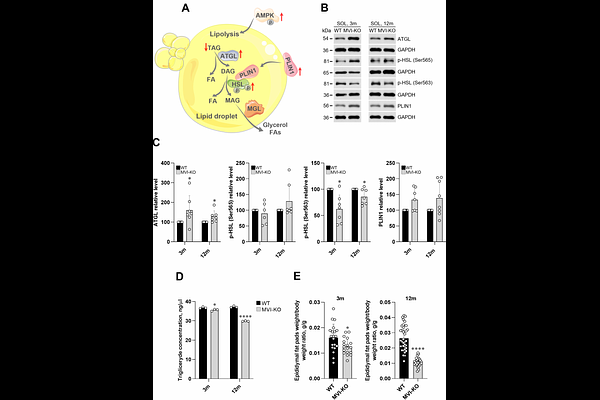Unconventional myosin VI is involved in the regulation of muscle energy metabolism

Unconventional myosin VI is involved in the regulation of muscle energy metabolism
Wojton, D.; Dymkowska, D.; Matysniak, D.; Topolewska, M.; Redowicz, M. J.; Lehka, L.
AbstractMitochondria are vital organelles that regulate metabolic state of skeletal muscle, and thus preserving their structure and function is crucial for the maintainance of skeletal muscle function. Unconventional myosin VI (MVI) is a minus-end-directed motor, in contrast to other known myosins, which are plus-end-directed. It is expressed in skeletal muscle and myogenic cells. To explore a potential role of MVI in mitochondrial function and muscle metabolism, we used mice lacking MVI (Snell\'s waltzer, SV), the natural MVI knockouts, alongside their heterozygous littermates. We examined muscle samples from newborn (P0) as well as adult 3- and 12-month-old mice and demonstrated that in control animals both MVI mRNA and protein expression is highest in the muscles of newborn mice and remarkably decreases with age. Moreover, MVI expression depends on a muscle type, with the highest levels in the slow-twitch soleus muscle (SOL) of adult animals. Remarkably, the effects of MVI loss are most pronounced in this muscle type, characterized by the highest number of mitochondria compared to fast-twitch muscles. Loss of MVI resulted in a significant reduction of the respiratory capacity of myogenic cells, accompanied by a decrease in the overall ATP production, confirming a compromised mitochondrial function. Interestingly, analysis of the myofiber types revealed that lack of MVI triggers glycolytic-to-oxidative fiber-type switch, which was more pronounced in SOL. Furthermore, we also observed an increased level of phospho-AMPK in MVI-KO SOL in all studied timepoints as well as downregulation of the mTOR pathway and upregulation of key proteins involved in lipolysis. These findings point at MVI as a new regulator of metabolic processes in skeletal muscle.